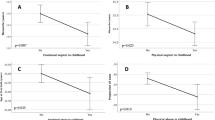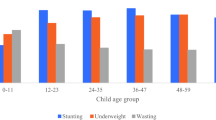Abstract
Aim
To examine the association between motherhood status (mothers, voluntarily childless, involuntarily childless) and overweight and obesity over 22 years.
Methods
A total of 4092 women aged 18–23 years were followed from 1996 to 2018. Motherhood status was defined by women’s reports on their fertility, attempts to conceive, use of in vitro fertilisation and fertility hormones, and number of biological children. Associations between motherhood status and overweight and obesity were examined using generalised estimating equations models, adjusting for socio-demographic characteristics, lifestyle factors, depressive symptoms, early life factors, and polycystic ovary syndrome (PCOS).
Results
At age 40–45 years, 12% of women were voluntarily childless and 5% were involuntarily childless. The prevalence of overweight and obesity increased with age and women who were voluntarily or involuntarily childless had higher prevalence of obesity than mothers in all surveys. After adjusting for covariates, compared with mothers, women who were voluntarily childless had higher odds of being overweight (odds ratio [OR], 95% confidence interval [CI]: 1.29, 1.09–1.52) and obese (OR, 95% CI: 1.65, 1.29–2.12). Involuntary childlessness was not associated with being overweight (OR, 95% CI: 1.05, 0.82–1.33), and its association with obesity was attenuated after adjusting for PCOS in the final model (OR, 95% CI: 1.40, 0.99–1.98).
Conclusions
Around one in nine Australian women remained voluntarily childless by their late reproductive years. On average, they had higher odds of being overweight and obese than mothers, suggesting that overweight and obesity prevention programs should consider tailoring their advice by motherhood status.
This is a preview of subscription content, access via your institution
Access options
Subscribe to this journal
Receive 12 print issues and online access
$259.00 per year
only $21.58 per issue
Buy this article
- Purchase on Springer Link
- Instant access to full article PDF
Prices may be subject to local taxes which are calculated during checkout


Similar content being viewed by others
Data availability
ALSWH survey data are owned by the Australian Government Department of Health and due to the personal nature of the data collected, release by ALSWH is subject to strict contractual and ethical restrictions. Ethical review of ALSWH is by the Human Research Ethics Committees at The University of Queensland and The University of Newcastle. De-identified data are available to collaborating researchers where a formal request to make use of the material has been approved by the ALSWH Data Access Committee. The committee is receptive of requests for datasets required to replicate results. Information on applying for ALSWH data is available from https://alswh.org.au/for-data-users/applying-for-data/.
References
World Health Organization. Key facts - obesity and overweight. 2021. https://www.who.int/news-room/fact-sheets/detail/obesity-and-overweight.
Sheehan TJ, DuBrava S, DeChello LM, Fang Z. Rates of weight change for black and white Americans over a twenty year period. Int J Obes Relat Metab Disord. 2003;27:498–504.
Australian Bureau of Statistics. National Health Survey: First results. Table 8:Body Mass Index, waist circumference, height and weight. 2018. https://www.abs.gov.au/statistics/health/health-conditions-and-risks/national-health-survey-first-results/2017-18.
Hu FB. Overweight and obesity in women: health risks and consequences. J Womens Health. 2003;12:163–72.
Nindrea RD, Aryandono T, Lazuardi L, Dwiprahasto I. Association of overweight and obesity with breast cancer during premenopausal period in Asia: a meta-analysis. Int J Prev Med. 2019;10:192.
Zhang Y, Liu H, Yang S, Zhang J, Qian L, Chen X. Overweight, obesity and endometrial cancer risk: results from a systematic review and meta-analysis. Int J Biol Markers. 2014;29:e21–9.
Rössner S. Pregnancy, weight cycling and weight gain in obesity. Int J Obes Relat Metab Disord. 1992;16:145–7.
Mannan M, Doi SA, Mamun AA. Association between weight gain during pregnancy and postpartum weight retention and obesity: a bias-adjusted meta-analysis. Nutr Rev. 2013;71:343–52.
Brown WJ, Hockey R, Dobson AJ. Effects of having a baby on weight gain. Am J Prev Med. 2010;38:163–70.
Zheng Y, Manson JE, Yuan C, Liang MH, Grodstein F, Stampfer MJ, et al. Associations of weight gain from early to middle adulthood with major health outcomes later in life. JAMA. 2017;318:255–69.
Lewis CE, Jacobs DR Jr., McCreath H, Kiefe CI, Schreiner PJ, Smith DE, et al. Weight gain continues in the 1990s: 10-year trends in weight and overweight from the CARDIA study. Coronary Artery Risk Development in Young Adults. Am J Epidemiol. 2000;151:1172–81.
Umberson D, Liu H, Mirowsky J, Reczek C. Parenthood and trajectories of change in body weight over the life course. Soc Sci Med. 2011;73:1323–31.
Laroche HH, Wallace RB, Snetselaar L, Hillis SL, Cai X, Steffen LM. Weight gain among men and women who have a child enter their home. J Acad Nutr Diet. 2013;113:1504–10.
Rosenberg L, Palmer JR, Wise LA, Horton NJ, Kumanyika SK, Adams-Campbell LL. A prospective study of the effect of childbearing on weight gain in African-American women. Obes Res. 2003;11:1526–35.
Gunderson EP, Murtaugh MA, Lewis CE, Quesenberry CP, West DS, Sidney S. Excess gains in weight and waist circumference associated with childbearing: the Coronary Artery Risk Development in Young Adults Study (CARDIA). Int J Obes Relat Metab Disord. 2004;28:525–35.
Brown DM, Barbara A, Cohen AK, Rehkopf DH. Motherhood, fatherhood and midlife weight gain in a US cohort: associations differ by race/ethnicity and socioeconomic position. SSM Popul Health. 2017;3:558–65.
Abrams B, Heggeseth B, Rehkopf D, Davis E. Parity and body mass index in US women: a prospective 25-year study. Obesity. 2013;21:1514–8.
Robinson WR, Cheng MM, Hoggatt KJ, Sturmer T, Siega-Riz AM. Childbearing is not associated with young women’s long-term obesity risk. Obesity. 2014;22:1126–32.
Davis D, Brown WJ, Foureur M, Nohr EA, Xu F. Long-term weight gain and risk of overweight in parous and nulliparous women. Obesity. 2018;26:1072–7.
Waren W, Pals H. Comparing characteristics of voluntarily childless men and women. J Popul Res. 2013;30:151–70.
Abma JC, Gladys MM. Childlessness among older women in the United States: trends and profiles. J Marriage Fam. 2006;68:1045–56.
Connidis IA, McMullin JA. Reasons for and perceptions of childlessness among older persons: Exploring the impact of marital status and gender. J Aging Stud. 1996;10:205–22.
Tanturri ML, Mencarini L. Childless or childfree? Paths to voluntary childlessness in Italy. Popul Dev Rev. 2008;34:51–77.
Awoke MA, Earnest A, Joham AE, Hodge AM, Teede HJ, Brown WJ, et al. Weight gain and lifestyle factors in women with and without polycystic ovary syndrome. Hum Reprod. 2021;37:129–41.
United Nations Department of Economic and Social Affairs. World Fertility Report 2013: fertility at the Extremes. 2014. https://www.un.org/en/development/desa/population/publications/pdf/fertility/worldFertilityReport2013.pdf.
Lee C, Dobson AJ, Brown WJ, Bryson L, Byles J, Warner-Smith P, et al. Cohort profile: the Australian Longitudinal Study on Women’s Health. Int J Epidemiol. 2005;34:987–91.
Dobson AJ, Hockey R, Brown WJ, Byles JE, Loxton DJ, McLaughlin D, et al. Cohort profile update: Australian Longitudinal Study on Women’s Health. Int J Epidemiol. 2015;44:1547,1547a–f.
World Health Organization. Obesity: preventing and managing the global epidemic. Geneva: World Health Organization; 2000.
National Key Centre for Social Applications of Geographical Information Systems, & Australia. Department of Health Aged Care. Measuring remoteness: accessibility/remoteness index of Australia (ARIA) (Revised Ed). Canberra: Department of Health and Aged Care; 2001.
Australian Bureau of Statistics. Technical paper: Socio-Economic Indexes for Areas (SEIFA). 2001. https://www.abs.gov.au/ausstats/abs@.nsf/DetailsPage/2033.0.55.0012011.
Brown WJ, Burton NW, Marshall AL, Miller YD. Reliability and validity of a modified self-administered version of the Active Australia physical activity survey in a sample of mid-age women. Aust N Z J Public Health. 2008;32:535–41.
National Health and Medical Research Council. Australian alcohol guidelines: health risks and benefits. Canberra (ACT): Commonwealth of Australia; 2001.
Andresen EM, Malmgren JA, Carter WB, Patrick DL. Screening for depression in well older adults: evaluation of a short form of the CES-D (Center for Epidemiologic Studies Depression Scale). Am J Prev Med. 1994;10:77–84.
Little RJ, Rubin DB. Statistical analysis with missing data, vol. 793. Hoboken: John Wiley & Sons; 2019.
Ceballo R, Lansford JE, Abbey A, Stewart AJ. Gaining a child: comparing the experiences of biological parents, adoptive parents, and stepparents. Family Relations. 2004;53:38–48.
Levy-Shiff R, Goldshmidt I, Har-Even D. Transition to parenthood in adoptive families. Dev Psychol. 1991;27:131–40.
Martínez-González MÁ, Alfredo Martinez J, Hu F, Gibney M, Kearney J. Physical inactivity, sedentary lifestyle and obesity in the European Union. Int J Obes. 1999;23:1192–201.
Ball K, Brown W, Crawford D. Who does not gain weight? Prevalence and predictors of weight maintenance in young women. Int J Obes. 2002;26:1570–8.
Brown WJ, Williams L, Ford JH, Ball K, Dobson AJ. Identifying the energy gap: magnitude and determinants of 5‐year weight gain in midage women. Obes Res. 2005;13:1431–41.
Luppino FS, de Wit LM, Bouvy PF, Stijnen T, Cuijpers P, Penninx BW, et al. Overweight, obesity, and depression: a systematic review and meta-analysis of longitudinal studies. Arch Gen Psychiatry. 2010;67:220–9.
Wiss DA, Brewerton TD. Adverse childhood experiences and adult obesity: a systematic review of plausible mechanisms and meta-analysis of cross-sectional studies. Physiol Behav. 2020;223:112964.
Simmonds M, Llewellyn A, Owen CG, Woolacott N. Predicting adult obesity from childhood obesity: a systematic review and meta-analysis. Obes Rev. 2016;17:95–107.
Conroy K, Sandel M, Zuckerman B. Poverty grown up: how childhood socioeconomic status impacts adult health. J Dev Behav Pediatr. 2010;31:154–60.
Kuhlmann AKS, Dietz PM, Galavotti C, England LJ. Weight-management interventions for pregnant or postpartum women. Am J Prev Med. 2008;34:523–8.
Price SA, Sumithran P, Nankervis A, Permezel M, Proietto J. Preconception management of women with obesity: a systematic review. Obes Rev. 2019;20:510–26.
Australian Government Department of Health: National obesity strategy 2022–2032: enabling Australians to eat well and be active. 2022. https://www.health.gov.au/sites/default/files/documents/2022/03/national-obesity-strategy-2022-2032_0.pdf.
Silalahi PCS, Setyonaluri D. My mother, my role model: mother’s influence on women’s fertility intention in Indonesia. Malays J Econ Stud. 2018;55:81–96.
Steiner AZ, Jukic AM. Impact of female age and nulligravidity on fecundity in an older reproductive age cohort. Fertil Steril. 2016;105:1584–8.e1.
Acknowledgements
The research on which this paper is based was conducted as part of the Australian Longitudinal Study on Women’s Health by the University of Queensland and the University of Newcastle. We are grateful to the Australian Government Department of Health for funding and to the women who provided the survey data.
Funding
CYJ is supported by China Scholarship Council (grant number: 202006010042) (https://www.csc.edu.cn/chuguo/s/1844). GDM is an Australian National Health and Medical Research Council Leadership Fellow (APP2009577). The funders had no role in study design, collection, analysis and interpretation of data, the writing of the article, and the decision to submit it for publication.
Author information
Authors and Affiliations
Contributions
CYJ and GDM contributed to all aspects of the study design. CYJ conducted the data analysis and drafted the manuscript with input from LRT and XLX. All authors were involved in interpreting the data and critically reviewing the manuscript drafts. All authors approved the final version of the manuscript.
Corresponding author
Ethics declarations
Competing interests
The authors declare no competing interests.
Ethical approval
The study was approved by the Human Research Ethics Committees of the Universities of Queensland and Newcastle.
Consent to participate
Informed consent was obtained from all individual participants included in the study.
Additional information
Publisher’s note Springer Nature remains neutral with regard to jurisdictional claims in published maps and institutional affiliations.
Supplementary information
Rights and permissions
Springer Nature or its licensor (e.g. a society or other partner) holds exclusive rights to this article under a publishing agreement with the author(s) or other rightsholder(s); author self-archiving of the accepted manuscript version of this article is solely governed by the terms of such publishing agreement and applicable law.
About this article
Cite this article
Jin, C., Tooth, L.R., Xu, X. et al. Is being childless associated with a woman’s risk of overweight and obesity? Results from a national longitudinal study. Int J Obes 47, 841–847 (2023). https://doi.org/10.1038/s41366-023-01329-x
Received:
Revised:
Accepted:
Published:
Issue Date:
DOI: https://doi.org/10.1038/s41366-023-01329-x



